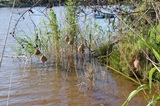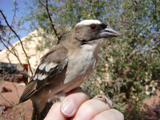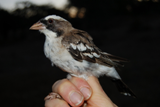Weaver news
| Harrison XA, York JE, Cram DL, Hares MC, Young AJ. 2013. Complete reproductive skew within white-browed sparrow weaver groups despite outbreeding opportunities for subordinates of both sexes. Behavorial Ecology and Sociobiology online. Abstract. The distribution of reproductive success within societies is a key determinant of the outcomes of social evolution. Attempts to explain social diversity, therefore, require that we quantify reproductive skews and identify the mechanisms that generate them. Here, we address this priority using life history and genotypic data from >600 individuals in 40 wild groups of the cooperatively breeding white-browed sparrow weaver, Plocepasser mahali. We show that groups comprise up to six males and seven females, but within-group reproduction is completely monopolised by a single dominant male and female, while extra-group males sire 12-18 % of offspring. Strong within-group kin structure could frequently explain these monopolies, as subordinates had typically delayed dispersal from their natal groups and so frequently (1) lacked within-group outbreeding partners, and/or (2) stood to gain little from contesting dominant reproduction, being almost as related to the dominant's young as they would have been to their own. Kin structure alone cannot account entirely for these monopolies, however, as they remained complete following the immigration of unrelated males and females. That subordinate females remain reproductively quiescent despite also showing comparable body condition to dominants, overlapping them substantially in age, and showing no evidence of elevated stress hormone levels raises the possibility that they exercise reproductive restraint due instead to a threat of action by dominants and/or deficits in offspring fitness that might arise if subordinates bred. Our findings highlight the complexity of the mechanisms that generate reproductive disparities in animal societies and the challenge of identifying them when skews are complete.
The study population comprised 40 cooperative groups of White-browed Sparrow-Weavers, which defended small year-round territories in an area of approximately 1.5 km2, in Tswalu Kalahari Reserve, Northern Cape, South Africa. All birds were given a metal ring and three colour rings, and records of group compositions were maintained with at least weekly visits. Adult males and females could be distinguished as males have dark bills and females have paler flesh-coloured bills (see photos), the distinction becoming apparent at about 3-6 months of age.
During the study period (October 2007 - April 2011), the 40 focal groups laid 0-6 clutches per group per year, resulting in 0-8 fledglings per group per year. The breeding season was from October to April and clutch initiation rates peaked after heavy rainfall. Clutches typically had two eggs (154 of 223 clutches), but ranged in size from 1-4 eggs. Incubation was 14-19 days from the laying of the first egg and the degree of hatching synchrony varied, with all chicks hatching 0-3 days apart. Social groups varied in size from 2-12 birds with about equal numbers of males and females. Groups were headed by a single female (the 'dominant female'), and a single male (the 'dominant male') that was closely associated with the dominant female, and was typically the last bird to enter the roost chambers at dusk. More news about this research group may be read at "Weaver birds may hold secret of ageing" Literature as featured in Weaver Watch news items |












